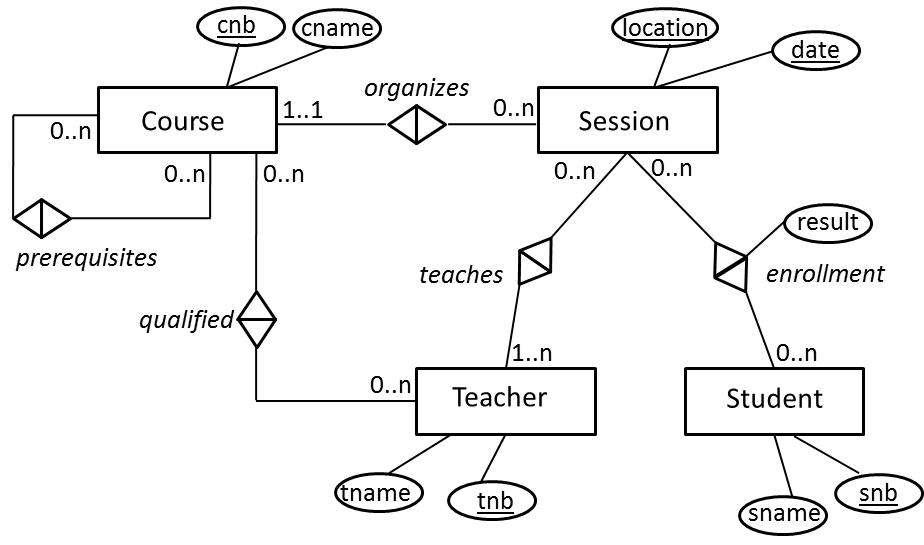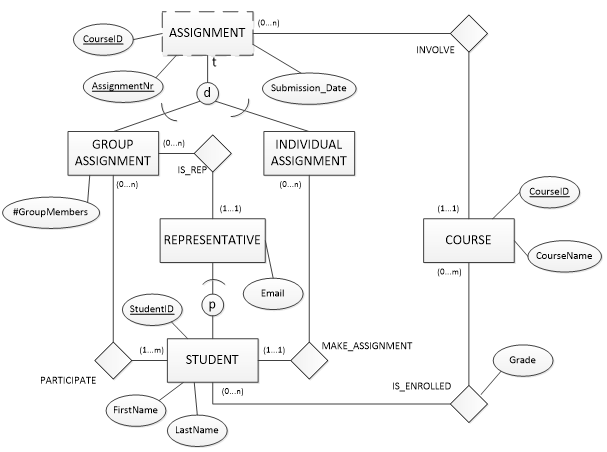MC Which statement is NOT CORRECT? In mapping an EER N:M relationship type to the relational model, we create a new relation R. Its primary key is the combination of the foreign keys referring to the primary keys of the relations corresponding to the participating entity types. incorrect A prime attribute type is an attribute type that is part of a candidate key. incorrect A foreign key can be NULL. incorrect An EER relationship type always asks for the creation of a new corresponding relation R in the relational model. correct
MC Given the following (normalized) relational model (primary keys underlined; foreign keys in italics):
EMPLOYEE(SSN, ENAME, EADDRESS, SEX, DATE_OF_BIRTH, SUPERVISOR, DNR)
SUPERVISOR: foreign key, refers to SSN in EMPLOYEE, NULL value not allowed
DNR: foreign key, refers to DNR in DEPARTMENT, NULL value not allowed
DEPARTMENT(DNR, DNAME, DLOCATION, MGNR)
MGNR: foreign key, refers to SSN in EMPLOYEE, NULL value not allowed
PROJECT(PNR, PNAME, PDURATION, DNR)
DNR: foreign key, refers to DNR in DEPARTMENT, NULL value not allowed
WORKS_ON(SSN, PNR, HOURS)
SSN: foreign key, refers to SSN in EMPLOYEE, NULL value not allowed
PNR: foreign key, refers to PNR in PROJECT, NULL value not allowed
Which statement is NOT CORRECT? An employee must work in the same department than he/she manages. correct Every employee must be always supervised by exactly one other employee. incorrect Every project is always assigned to exactly one department. incorrect A department has always exactly one manager. incorrect
MC Given the following (normalized) relational model (primary keys underlined; foreign keys in italics):
EMPLOYEE(SSN, ENAME, EADDRESS, SEX, DATE_OF_BIRTH, SUPERVISOR, DNR)
SUPERVISOR: foreign key, refers to SSN in EMPLOYEE, NULL value not allowed
DNR: foreign key, refers to DNR in DEPARTMENT, NULL value not allowed
DEPARTMENT(DNR, DNAME, DLOCATION, MGNR)
MGNR: foreign key, refers to SSN in EMPLOYEE, NULL value not allowed
PROJECT(PNR, PNAME, PDURATION, DNR)
DNR: foreign key, refers to DNR in DEPARTMENT, NULL value not allowed
WORKS_ON(SSN, PNR, HOURS)
SSN: foreign key, refers to SSN in EMPLOYEE, NULL value not allowed
PNR: foreign key, refers to PNR in PROJECT, NULL value not allowed
Which statement is NOT CORRECT? A department has always exactly one manager. incorrect An employee must work in the same department than he/she manages. correct Every project is always assigned to exactly one department. incorrect Every employee must be always supervised by exactly one other employee. incorrect
MC A relation is in 3 NF if it satisfies 2 NF and... no primary key of R is transitively dependent on a prime attribute type. incorrect no prime attribute type of R is transitively dependent on the primary key. incorrect no non-primary key of R is transitively dependent on a prime attribute type. incorrect no nonprime attribute type of R is transitively dependent on the primary key. correct
MC Given the following relational model (primary keys are underlined, foreign keys are in italics)
BOOK(ISBN, title, pages, price, publishername)
AUTHOR(authorname, date_of_birth)
WRITES(authorname, ISBN)
PUBLISHER(publishername, streetnumber, streetname, zipcode)
CITY(zipcode, city)
The assumptions are: - Each book has a unique ISBN number
- Each author has a unique name
- Each publisher has a unique name
- A book can have multiple authors
- An auther can write more than one book
- A publisher can publish more than one book
- A book can have multiple publishers
- A publisher has only one address
Which statement is CORRECT? The relational model is not in first normal form. correct The relational model is in first normal form but not in second normal form. incorrect The relational model is in second normal form but not in third normal form. incorrect The relational model is in third normal form. incorrect
MC Consider a data model for the Olympics storing information about countries and athletes. There is a 1-N relationship type between country and athlete and an athlete always has to belong to exactly 1 country. A relational data model containing only 1 table leads to: Unnecessary replication of data about countries. correct Unnecessary replication of data about athletes and countries. incorrect No unnecessary replication of data. incorrect Unnecessary replication of data about athletes. incorrect
MC Given the following relational model (primary keys are underlined, foreign keys are in italics)
BOOK(ISBN, title, pages, price, publishername)
AUTHOR(authorname, date_of_birth)
WRITES(authorname, ISBN)
PUBLISHER(publishername, streetnumber, streetname, zipcode)
CITY(zipcode, city)
The assumptions are: - Each book has a unique ISBN number
- Each author has a unique name
- Each publisher has a unique name
- A book can have multiple authors
- An auther can write more than one book
- A publisher can publish more than one book
- A book can have multiple publishers
- A publisher has only one address
Which statement is CORRECT? The relational model is in first normal form but not in second normal form. incorrect The relational model is not in first normal form. correct The relational model is in third normal form. incorrect The relational model is in second normal form but not in third normal form. incorrect
MC Consider the following ER model for a course administration.

Which statement is NOT CORRECT? When mapping the ER relationship type enrollment between Session and Student to the relational model, a new relation needs to be introduced. The 4 cardinalities of this ER relationship type can be perfectly mapped to the relational model. incorrect When mapping the ER relationship type teaches between Session and Teacher to the relational model, a new relation needs to be introduced. The 4 cardinalities of this ER relationship type can be perfectly mapped to the relational model. correct Both the ER and the relational model cannot enforce that a teacher can only teach sessions of courses for which he/she is qualified. incorrect When mapping the ER relationship type organizes between Course and Session to the relational model, the primary key "cnb" of the Course relation will be included as a NOT NULL foreign key in the Session relation. The 4 cardinalities of this ER relationship type can be perfectly mapped to the relational model. incorrect
MC Consider the following ER model for a course administration.

Which statement is NOT CORRECT? When mapping the ER relationship type teaches between Session and Teacher to the relational model, a new relation needs to be introduced. The 4 cardinalities of this ER relationship type can be perfectly mapped to the relational model. correct When mapping the ER relationship type organizes between Course and Session to the relational model, the primary key "cnb" of the Course relation will be included as a NOT NULL foreign key in the Session relation. The 4 cardinalities of this ER relationship type can be perfectly mapped to the relational model. incorrect When mapping the ER relationship type enrollment between Session and Student to the relational model, a new relation needs to be introduced. The 4 cardinalities of this ER relationship type can be perfectly mapped to the relational model. incorrect Both the ER and the relational model cannot enforce that a teacher can only teach sessions of courses for which he/she is qualified. incorrect
MC Consider the following EER model

Which statement is CORRECT? When mapping the EER relationship type INVOLVE between COURSE and ASSIGNMENT to the relational model, a new relation needs to be introduced. The 1..1 cardinalities of this relationship type cannot be enforced in the relational model. incorrect When mapping the EER relationship type PARTICIPATE between GROUP ASSIGNMENT and STUDENT to the relational model, a new relation needs to be introduced. The 4 cardinalities of this EER relationship type can be perfectly mapped to the relational model. incorrect The partial inheritance relationship between STUDENT and REPRESENTATIVE can be perfectly mapped to the relational model by the following two relations: STUDENT(StudentID, FirstName, LastName) and REPRESENTATIVE (S-StudentID, Email) whereby S-StudentID refers to StudentID in STUDENT. correct When mapping the EER relationship type IS_ENROLLED between COURSE and STUDENT to the relational model, a new relation needs to be introduced. The relation is identified by GRADE as its primary key. incorrect


